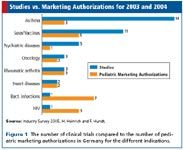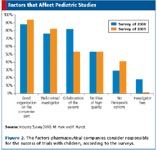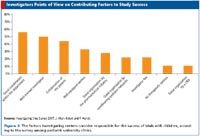Pediatric Research in Germany
Applied Clinical Trials
Surveys among pharma, clinics, and investigators shed light on trials in children.
Related Articles
1. EUs Pediatric Regulation Sees First Approval:
2. Making Reality of Pediatric Rhetoric
3. Pediatric Policies Grow Up
Sufficient pediatric information on medicines used in children should be available; thus, pediatric clinical research should be enhanced. This is a consensus on a global basis and is now considered a public health priority. An increasing number of clinical trials are expected due to emerging laws and guidelines and governmental support and funding.1
Some background
Pharmaceutical companies are subject to market economy with assignment of limited resources to profitable products. Because the rules of market economy are not sufficient to create a demand in pediatric research, there is a need for societal intervention.2 The first effective measure addressing this issue was realized in 1997, when the Food and Drug Modernization Act (FDAMA) was adopted.

PHOTOGRAPHY: GETTY IMAGES ILLUSTRATION: PAUL A. BELCI
The measures of FDAMA encouraged companies to conduct studies of certain therapies being used in pediatrics by providing an exclusivity incentive provision.3 Further regulations followed including the Pediatric Research Equity Act, enabling the FDA to force companies to study certain drugs in children.4
Between 1998 and 2004, 253 studies were submitted to the FDA for pediatric exclusivity. Labeling changes were positive for 127 of the 253 studies (50%). As a result of these changes in regulations and legislation in the United States, more trials have been done in children in these five years than in the previous 30 and there has been an improvement in safety information as well as dose changes for pediatric prescribing.5
On January 26, 2007, 10 years after FDAMA was adopted, the European Pediatric Regulation 1901/2006 came into force.1 This regulation obliges the pharmaceutical industry to conduct clinical trials with children but can be waived for medicines that are unlikely to benefit them. In some cases, studies may be deferred until the medicine has been authorized for use in adults.
The manufacturers will be compensated by a six-month extension of the supplementary protection certificate for conducting the pediatric development. In addition, there are programs that fund the pediatric development of substances without a supplementary protection certificate.
The directive 2001/20/EC on Good Clinical Practice was adopted on the EU level in April 2001 and was implemented in Germany in August 2004. The directive's aim was to simplify and harmonize administrative procedures governing trials to provide patient protection by setting pan-European legal standards. Furthermore, the directive takes specific concerns into account regarding clinical trials with children and specifies criteria for their protection as study patients.6
The EU has set up regulations to improve the quality and quantity of pediatric clinical trials. But what are the issues of clinical research with children in practice? Pediatric clinics and the pharmaceutical industry are two of the main parties involved in the conduct of pediatric clinical trials. Therefore, the authors wanted to evaluate the experiences these two parties had when conducting pediatric clinical trials with children in Germany. Furthermore, the number of studies conducted in the past and present and the number of expected future studies was part of the evaluation.
Pediatric research
The results of the two surveys showed that the pharmaceutical companies' activity with regard to pediatric clinical research in Germany was constant from 2000 until the implementation of the clinical trials directive. Of the replying companies, 60.7% vs. 66.7% conducted at least one clinical trial with children in the questioned time frames.
According to the results of both surveys, 18 companies conducted clinical trials with children. Each survey demonstrated an average of 32 performed studies annually.
AGE GROUPS AND INDICATIONS STUDIED. Both surveys showed that the majority of studies were conducted with children (ages two to 11 years). Only a few studies were conducted with preterm and term infants.
The companies were asked to choose from indications that were considered likely to be of interest for investigations in children. The number of the studies reported in the 2005 survey, which are linked to the number of marketing authorizations in pediatric indications, are shown in Figure 1.

Studies vs. Marketing Authorizations for 2003 and 2004
Finding investigators
Concerning the recruitment of investigators for clinical trials with children the results of the two surveys were inhomogeneous. One-third of the respondents of the first survey in 2000 reported that they had some problems finding qualified investigators. In contrast, the second survey indicated that more than two-thirds of the companies found the recruitment of investigators difficult.

Survey Methodology
Although only one company reported investigators who were not willing to expose children to the "stress" of a clinical trial, it was rather difficult to find investigators for trials with young children or for trials with pharmacokinetic blood sampling, according to the survey of 2005. In both surveys, a fractional lack of theoretical knowledge and practical experience concerning clinical trials with children on the investigators' part were mentioned.
The companies were also asked to choose from factors that contribute to the success or failure of clinical trials with children. The results were relatively homogenous in both surveys. Almost all companies assessed their own good organization of the study as an important requirement. The investigators' financial compensation was of lowest importance for the feasibility of the trials (18% in 2000 vs. <1% in 2005). The results are shown in detail in Figure 2.

Factors that Affect Pediatric Studies
According to both surveys, there were no specific precautions on the ethics committees' parts. The causes for rejection reported were age limit concerns, insufficient data from adults, certain safety concerns, and objections concerning the written subject information. The clinical trials directive, and hence the requirement of health authority approval, was implemented in Germany in August 2004. We assumed that the majority of studies would have started before the implementation and, therefore, the companies were not asked about their experiences with the health authorities.
University clinics
In order to gather information from the investigator's point of view, a similar survey among pediatric university clinics was conducted in 2007.11 The questionnaire was adapted for this survey,10,11 but basically covered the same aspects as the pharmaceutical industry survey. In February 2007, the questionnaire was sent to 68 pediatric departments in 31 university clinics in Germany. These 68 centers consist of 30 general pediatric departments, 14 departments of pediatric cardiology, nine departments of pediatric oncology, six departments of pediatric neurology, four departments of neonatology, two departments of pediatric psychiatry, two departments of pediatric nephrology, and one department for pediatric surgery. Pediatric university clinics were selected based on the assumption that clinical research activities are more likely conducted in academic settings.
Despite several reminders, only 27% of the 68 pediatric centers responded (18 centers). Five centers replied that they would not participate due to lack of time. Most of the oncology departments did not participate because "nearly every patient" takes part in "therapy optimization studies"—a special term used in the oncology field.
All 18 centers performed trials with children between 2004 and 2006. In total, 229 studies in 18 centers were reported. However, in the case of multicenter studies, it might be possible that the same trial was reported by more than one center. According to the responses from 16 centers that intended to conduct trials with minors in 2007 and 2008, a minimum of 124 studies were expected to be performed.
With respect to new laws, guidelines, and government support, the authors expected an increased number of clinical trials in children. However, the figures indicated a decreased number in the future; although incomplete plans at the centers may be an explanation for the low figures.
The two surveys among the pharmaceutical firms and literature sources indicate that the majority of clinical trials are conducted with older children (six to 18 years) rather than with younger ones. Few data on randomized trials with very young children (preterm infants and infants) is available.2 Data from this survey is limited due to the low number of responding departments. However, the results indicate that trials are performed in all age classes, including in the very young, with a focus on trials in cardiology and metabolic diseases.
Sponsorship of trials
The majority of studies accounted for in this survey were investigator sponsored trials/investigator initiated trials (IST/IIT). Most of them are supported by the pharmaceutical industry. One-third of the centers reported that the outcomes of the trials conducted in their department would be used for an initial marketing authorization. More than half stated that the trial results are intended for an extension of the indication for children. Most of these clinical trials were conducted with medicinal products already registered in adults or for other indications.
A similar multiple-choice part assessing reasons for the success or failure of clinical trials was part of this questionnaire, with factors adjusted for the investigator's perspective. Most of the centers (10 of 18) named good coordination by their center as the predominant factor for the trial's success. Only five centers considered good organization by the pharma company responsible for the success of the study. In contrast, almost all companies considered their good organization as a requirement.
It should be noted that most of the studies reported by the centers are ISTs/IITs. Thus, no organization by the pharmaceutical industry is needed. In opposition to the results of the company surveys, 22% of the responders (four of 18) cited the rate of the investigator's fee as a reason for the good conduct of the trial. Complete results on feasibility are shown in Figure 3.

Investigators Points of View on Contributing Factors to Study Success
The results of both surveys conducted within the pharmaceutical industry were confirmed by each other. Furthermore, the survey undertaken within German university departments shows similar results: 89% (16 of 18) of the centers answered that none of their clinical trials were refused by the ethics committees or health authorities. Only one center (one of 18) had experience where one project was refused. This could demonstrate high-quality study preparation (e.g., quality of medicinal product, study design, study protocol, informed consent) as well as a good collaboration with the ethics committees and health authorities.
Conclusion
The EU regulation on medicinal products for pediatric use set up carrot-and-stick measures for the pharmaceutical industry. Hence, the number of industry sponsored trials with minors should increase, as it did according to the measures set up by the United States.
The three surveys consulted with the pharmaceutical industry and investigators, and therefore adequately mirror pediatric clinical research in Germany from 2001 to 2008. The results of both surveys conducted within the pharmaceutical industry were confirmed by each other. Furthermore, the survey undertaken within German university departments shows similar results. According to these results, the Clinical Trials Directive (2001/20/EG) implemented in Germany in 2004 has had no effect on the number of trials performed in Germany in the pediatric population so far.
Of course, as it is normal in surveys, limitations with respect to the number of participating companies and university clinics has to be considered. In both pharma surveys the response rate was very good compared to the response rate of the investigational sites. Nevertheless, a broad spectrum in the pediatric field is represented.
One may conclude from the results of our surveys that the pharmaceutical industry is more interested in pediatric clinical research than the pediatricians. However, the regulation focuses on clinical research carried out by the pharmaceutical industry, whereas pediatric IST/IIT are not in the scope of this legislation. The future of investigator sponsored trials is uncertain since the new regulations make them more complex and expensive. Investigators are afraid that the high administrative efforts associated with the directive and the enormous trial costs make IST/IIT almost impossible.12
The long-awaited EU regulation concentrating on industry sponsored trials is in the spotlight at the moment. However, funding independent academic pediatric research should not be neglected, since it has yielded many of the great medical discoveries—but it's now practically impossible for the investigators without drug company support.13
The EU regulations and guidelines were developed in order to increase the quality and quantity of clinical trials with children. The manufacturers and investigators are the stakeholders effected by these regulations. However, as confirmed by the three surveys, parents also play a highly important role when their children are a subject in a clinical trial. Clinical research involving children should also be discussed outside the forums of pharmaceutical companies, academic researchers, and politicians. It can only be successful if parents are sufficiently informed and involved.
The impression that all initiatives from a EU regulatory point of view did not increase the number of trials (i.e., no positive trend visible) should be checked again in both institutions and will be reflected by the number of PIPs that were accepted by EMEA in 2008 and that are accepted in 2009. The authors plan to follow the consequences of the regulations.
Acknowledgement
The authors gratefully acknowledge all the centers and companies that participated in these surveys.
References
1. Regulation (EC) No 1901/2006 of the European Parliament and of the Council on Medicinal Products for Pediatric Use, Amended by Regulation (EC) No 1902/2006, 12 December 2006.
2. K. Rose, "Better Medicines for Children—Where Are We Now, and Where Do We Want to Be?" British Journal of Clinical Pharmacology, 59 (6) 657-659 (2005).
3. Food and Drug Modernization Act of 1997, 105th Congress of the United States of America, 7 January 1997.
4. Pediatric Research Equity Act of 2003, 108th Congress, 7 January 2003.
5. P.H. Caldwell et al., "Clinical Trials in Children," Lancet, 364, 803-811 (2004).
6. Directive 2001/20/EC of the European Parliament and of the Council, 4 April 2001.
7. H. Heinrich and F. Hundt, "Pediatric Clinical Trials in Germany," Applied Clinical Trials, Novemer 2002, 56-62.
8. M. Hark et al., "Arzneimittelstudien bei Kindern in Deutschland," PharmInd–die pharmazeutische industrie, 68 (6) 693-698 (2006).
9. Verband forschender Arzneimittelhersteller (German Association of research-based pharmaceutical companies), www.vfa.de
10. J. Khan-Boluki, Master's Thesis Children in Clinical Trials: Survey on the Current Situation in Pediatric University Clinics in Germany's University of Duisburg/Essen, Germany, July 2007.
11. J. Khan-Boluki and F. Hundt, "Children in Clinical Trials: Survey on the Current Situation in Pediatric University Clinics in Germany," GMS German Medical Science 2008, http://www.egms.de/en/gms/2008-6/000046.shtml
12. L. Welzing et al., "Consequences of Directive 2001/20/EC for Investigator-Initiated Trials in the Pediatric Population—A Field Report, European Journal of Pediatrics, 166 (11) 1169-1176 (2007).
13. A. Hemminki et al., "Harmful Impact of the EU Clinical Trials Directive," BMJ, 332 (7540) 501-502 (2006).
Mareile Hark is clinical trial leader, Novartis Vaccines & Diagnostics s.r.l. Jasmin Khan-Boluki is clinical program leader, Sandoz Biopharmaceuticals. Ferdinand Hundt* is director clinical operations, Sanofi-Aventis Deutschland GmbH, email: ferdinand.hundt@sanofi-aventis.com
*To whom all correspondence should be addressed.
